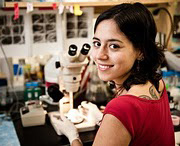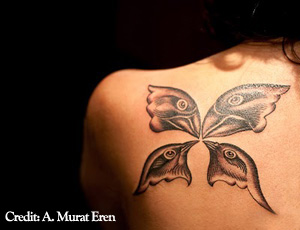Tulane grad translates
evolutionary biology for Turkish readers

B. Duygu Özpolat [DOO-ē-goo]
is a postdoc in
Alexandra Bely’s lab at the University of
Maryland. Last fall she attended the short course,
Concepts and Model Organisms in Regenerative
Biology, in Santiago, Chile sponsored by
the Society for Developmental Biology and the
Latin American Society for Developmental Biology.
She spoke with SDB about her research, the work she
does translating evolutionary biology texts into
Turkish, and her really
cool tattoo.
What was your degree in? Where are you now?
I studied Biology in
Turkey and recently got my Ph.D. [in Cell and
Molecular Biology] from Tulane University, where I
studied development and regeneration of the joint
tissue in
Dr. Ken Muneoka’s laboratory. Besides
developmental biology and regeneration, I have
always been very interested in evolutionary biology.
As a result, I found myself wondering how
regenerative abilities in different organisms evolve
or how certain organisms lose this ability while
their ancestors clearly were able to regenerate. I
have just started working in Dr. Alexa Bely’s lab as
a postdoctoral researcher on evolution of
regeneration using annelid worms as a model.
How
did you get involved translating
Understanding Evolution
[University of California, Berkeley] into
Turkish?
As far as I can remember in my
science education, there has always been
anti-evolution propaganda in Turkey and it was very
obvious that something had to be done about this.
After I graduated from university and came to the
USA for graduate school, a couple of my classmates
in Turkey asked if I would like to help them with
translating a website for educating the public about
evolutionary theory. This was exactly my kind of
thing because I love volunteer work and I think
public outreach is a very important part of being a
scientist. We call ourselves
Hard-workers for Evolution. There are more than
100 university students, graduate students,
post-docs and faculty in this volunteer organization
who pitch in at different levels. I know how hard it
is to accomplish such an immense amount of
translations with such good quality, which is why I
am very proud of everybody in our team for the work
they have done and their dedication.
Why was Understanding Evolution such an
important site to translate?
Firstly, because before we
translated this website, there was not any website
which purely focused on teaching evolution in
Turkish. If you made a Google search at that time,
you would find nothing but anti-evolution
propaganda, or some blogs that tried to fight the
anti-evolution propaganda, and even though there
were very decent blogs among them, it was all a part
of a disturbing fight. We agreed that, as
scientists, it is not our job to challenge people’s
religious beliefs. We also believe that the
anti-evolution propaganda is not worth wasting our
time and breath on. Understanding Evolution
website prepared by University of California,
Berkeley was a great resource that covered many
different aspects of evolution with fun, colorful
essays and with a peaceful attitude. Their guide for
teachers on how to handle certain situations in the
classroom is also a great resource.
What
is the process for translating a book like Richard
Dawkins’
The Greatest Show on Earth: The Evidence for
Evolution?
As a part of the volunteer work
we did for translating Understanding Evolution,
we first had to put a glossary of biological terms
together, because there were many terms that were
not properly translated into Turkish. We made this
glossary available to the public so everybody
can use it. When one of our volunteers (Uygar Polat)
was offered the job of translating Dawkins’ latest
book [The Greatest Show on Earth: The Evidence
for Evolution], he decided to make this a team
project and we formed a group of four, Uygar being
the editor. Everybody had a number of chapters to
translate. Once all the editing and translations
were complete, we read the book one last time, made
necessary corrections and finally got it printed. So
far we have been getting great reactions from the
readers concerning the quality of the translation. I
think one of the greatest things about establishing
a volunteer organization for making scientific
translations is that, you create an educated bunch
of young academics who are now equipped to make good
translations.
What are your future plans with the Hard-workers
for Evolution?
We have an ongoing project
which is funded by the European Society for
Evolutionary Biology (ESEB). We prepared information
packages composed of a DVD, with an offline version
of Understanding Evolution website in Turkish
as well as printable pdf files of all the content,
and brochures. We are currently sending these
packages out to elementary and high school science
teachers as well as libraries all around Turkey. By
this, we are hoping that the Turkish
Understanding Evolution website will become more
widely known and even those teachers in small
villages who do not have an internet connection all
the time can use the DVD as teaching material for
their classes.
What are your impressions from the Concepts and
Model Organisms in Regenerative Biology course in
Chile?
The course is Chile was one of
the best experiences (if not the best) in my life.
As somebody who is interested in evolution of
regeneration, it is especially great to be exposed
to different model organisms that can be used in the
study of regeneration phenomenon. From the most
classical limb regeneration model in axolotl, to sea
cucumbers, this course was everything I could ask
for at this point in my science career. It broadened
my perspective so much. Interacting with scientists
who have accomplished so much and who are basically
celebrities for a graduate student like me was
fantastic. The interactive way seminars took place,
with lots of students comfortably asking questions
and having discussions with the speaker was
something you do not experience much in the more
formal atmosphere of scientific meetings. The lab
sessions were perfectly designed—we had so much
hands-on experience. If I were to complain about
this course, my only complaint would be that it was
too short!
 Describe
the process for choosing your cool science tattoo? Describe
the process for choosing your cool science tattoo?
I wanted a tattoo for a long
time and finally decided to get Darwin's finches but
I wanted it to look like a butterfly. The idea
itself evolved while I was talking to my friends and
family about it. And the tattoo artist,
Henry Rhodes, made it become real—even better
than I imagined.
Check out the
full story on Duygu’s blog, Frizzled Thoughts of
a Knotty Mind.
|